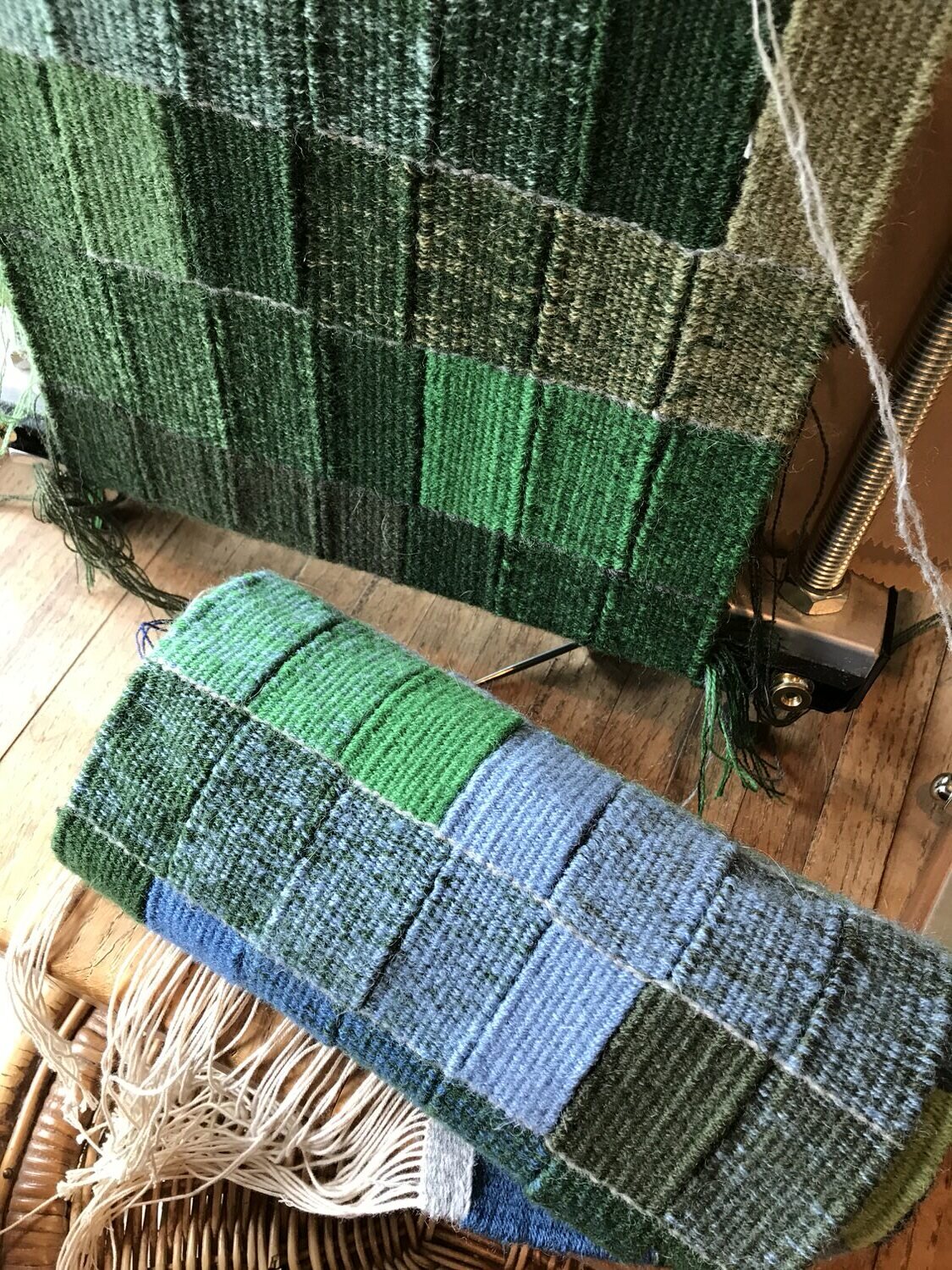Color-Blending in Tapestry
Most of my weavings from 2018 to present have involved color blending with either Faro or Mora or a combination between the two.
I love the more rustic nature of Faro - and the colors are more vibrant than Mora.
Borgs Mora and Faro, two of my favorite weft yarns
But what I like about Mora is the weight. It’s a 20/2 wool yarn, very fine, like lace-weight. I can blend 5 strands together at 8EPI; the sett I most often work with. I get tired of weaving small samples to try out color combinations so decided to weave myself some resources to work from for future weavings.
Since I keep all the colors stocked, I came up with a plan to do little samples of the variations, starting with all blues, then blue-greens, greens- working my way around the color wheel.
Mirrix “Little Guy” with extenders warped and ready - yes! I have an extensive button collection, too!
A tapestry diary of sorts. I didn’t want it to take up all my weaving time, so settled on doing one combination a day. I warped my Little Guy with extenders and figured I could do a triptych. One section for every 4 months. Seven blocks across. Looking back, I don’t know why this would matter since I have no wall space left in my studio for them to hang; they’ve become scrolls instead!
Greens on the looms with blue to blue green “scroll” for first 4 months
It’s the first weaving I did each day. That’s why I thought of it like a tapestry diary. And it was a hugely satisfying part of the day!
I have the little color samples of Mora (yarn-in-a-jar from Vavstuga) so first I arranged the blues according to value and wrote them down from darkest to lightest. I put numbers on each of the color cards to keep them straight. I actually wrote each combination out day by day in my journal to estimate what kind of outcome - as in how many days this project is going to be - to expect.
The six blues used and marked by value
My pattern went like this:
Day 1: Darkest blue, Navy - 5 strands
Day 2: Navy 4 strands with 1 strand next darkest blue, Ultramarine
Day 3: Navy 3 strands with 2 strands Ultramarine
Day 4: Navy 2 strands with 3 strands Ultramarine
Day 5: Navy 1 strand with 4 strands Ultramarine
Day 6: Ultramarine - 5 strands
Then I would start the sequence again with darkest blue and next darkest blue
Day 7: Navy - 5 strands
Day 8: Navy 4 strands with 1 strand of next to the next darkest blue, Yale
Day 9: Navy 3 strands with 2 strands Yale
Day 10: Navy 2 strands with 3 strands Yale
Day 11: Navy 1 strand with 4 strands Yale
Day 12: Yale - 5 strands
Then again, I would begin the sequence with Navy and the next lightest blue (Teal) - and so on.
Repeating the starting hue helped me to keep track of where I was in the sequence. I didn’t need to write it out or refer to my journal any longer after this point.
I had originally planned to go right into the greens the same way, but when I thought about all those blue/green and green/blue possibilities, I couldn’t pass them up. I’ve got some definite favorites in that bunch!
I also reversed the order and since I had ended with lightest blue, I started with lightest green. After exhausting all the blue/green possibilities I reversed the order again and went thought the greens starting with the darkest.
Section showing some of the colors chosen for Counterpoints
I’ve enjoyed doing this experiment. I know I’ll use it in the future. In fact, I already have. You can see the sections I used in the photo above in the piece below.
MoFA Counterpoints 2020 project; my part finished and ready for my partner to complete (more on that in a future post)
This is the piece I did for the MoFA Counterpoints challenge. I wove this piece on the side to get the gradations to go from darkest at the bottom to the lightest at the top. I chose three base colors that seemed to work well together in the samples. Each of the three are blended with the same color, which was also used (one strand with 4 of main grid color) in the grid around the blended areas.
Counterpoints project in progress
Using photoshop gave me an idea of how the colors would hang together. Not completely fool-proof, but a start.
Planning with Photoshop
At the end of August, I needed the loom. I’ve taken a break with this color-blending project for now but plans are to get back to it soon. I’ve missed it in my daily practice!
The most challenging part of this project - or a tapestry diary in general - has been to devote one loom for an entire year to it. I’d best get used to it, though, if I want to get through all the colors. It could take years. And then…?







